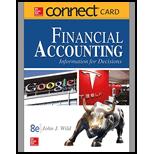
Concept explainers
1.
Introduction:
Inventory is a record of finished goods of a company which they can sell to the customer, work in progress which can be transformed into finish goods and raw material which is a means of production. Inventory is also classified as a current asset in the
To calculate: The total cost of goods available for sale and the number of units available for sales.
2.
Introduction:
Inventory is a record of finished goods of a company which they can sell to the customer, work in progress which can be transformed into finish goods and raw material which is a means of production. Inventory is also classified as a current asset in the balance sheet and it is valued by FIFO LIFO and weighted average method.
To compute: The number of unit in ending inventory for the company M.
3.
Introduction:
Inventory is a record of finished goods of a company which they can sell to the customer, work in progress which can be transformed into finish goods and raw material which is a means of production. Inventory is also classified as a current asset in the balance sheet and it is valued by FIFO LIFO and weighted average method.
To compute: The cost assigned to ending inventory for the company M using FIFO,LIFO and weighted average and specific identification.
4.
Introduction:
Inventory is a record of finished goods of a company which they can sell to the customer, work in progress which can be transformed into finish goods and raw material which is a means of production. Inventory is also classified as a current asset in the balance sheet and it is valued by FIFO LIFO and weighted average method.
To compute: The gross profit earn by the company is cost assigned to ending inventory for the company A using FIFO,LIFO and weighted average and specific identification.
Want to see the full answer?
Check out a sample textbook solution
Chapter 5 Solutions
Connect Access Card for Financial Accounting: Information and Decisions
- Nonearrow_forwardCurrent Year Data below are from recent annual reports for Samsung, Apple, and Google. Apple Current Year Samsung Prior Year Total revenue Total employees $ 197,690,938,000 $ 209,163,262,000 $ 260,174,000,000 98,753 101,546 137,000 Required: Google Current Year $ 161,857,000,000 118,899 1. Compute revenue per employee for Samsung for the current year and the prior year. 2. Using revenue per employee, did Samsung's workforce become more effective in generating revenues in the current year versus the prior year? 3. Which company, Apple, Google, or Samsung, was most effective at generating revenue in the current year based on revenue per employee? Complete this question by entering your answers in the tabs below. Required 1 Required 2 Required 3 Compute revenue per employee for Samsung for the current year and the prior year. Total revenue Number of employees Revenue per employee Samsung, Current Year Samsung, Prior Yeararrow_forwardA company borrowed $12,500 by signing a 150-day promissory note at 7.5% interest. What is the maturity value of the note?arrow_forward
 Financial And Managerial AccountingAccountingISBN:9781337902663Author:WARREN, Carl S.Publisher:Cengage Learning,
Financial And Managerial AccountingAccountingISBN:9781337902663Author:WARREN, Carl S.Publisher:Cengage Learning, Financial AccountingAccountingISBN:9781337272124Author:Carl Warren, James M. Reeve, Jonathan DuchacPublisher:Cengage LearningPrinciples of Accounting Volume 1AccountingISBN:9781947172685Author:OpenStaxPublisher:OpenStax College
Financial AccountingAccountingISBN:9781337272124Author:Carl Warren, James M. Reeve, Jonathan DuchacPublisher:Cengage LearningPrinciples of Accounting Volume 1AccountingISBN:9781947172685Author:OpenStaxPublisher:OpenStax College Financial AccountingAccountingISBN:9781305088436Author:Carl Warren, Jim Reeve, Jonathan DuchacPublisher:Cengage Learning
Financial AccountingAccountingISBN:9781305088436Author:Carl Warren, Jim Reeve, Jonathan DuchacPublisher:Cengage Learning Intermediate Accounting: Reporting And AnalysisAccountingISBN:9781337788281Author:James M. Wahlen, Jefferson P. Jones, Donald PagachPublisher:Cengage Learning
Intermediate Accounting: Reporting And AnalysisAccountingISBN:9781337788281Author:James M. Wahlen, Jefferson P. Jones, Donald PagachPublisher:Cengage Learning Cornerstones of Financial AccountingAccountingISBN:9781337690881Author:Jay Rich, Jeff JonesPublisher:Cengage Learning
Cornerstones of Financial AccountingAccountingISBN:9781337690881Author:Jay Rich, Jeff JonesPublisher:Cengage Learning





